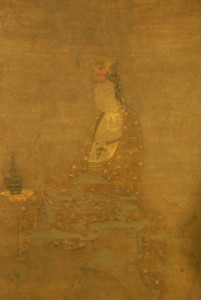Kose School / Schools of Nihonga 009
Kose School
Kose School is a family of court artists founded by Kanaoka Kose in the latter half of the 9th century, during the early Heian period. This school does not represent a single style of painting like other schools, but the various painting styles created by Kanaoka Kose and his descendants and pupils. This school changed Chinese style paintings with Chinese themes into Japanese style and played a major role in the formation of yamato-e painting style. Artists following Kanaoka include Oumi, Kinmochi, Kintada and Hirotaka. Many artists of this school worked at edokoro (official bureau of
painting) of Daijou’in and Ichijjou’in at Koufukuji temple during the Kamakura period and dominated major positions among Buddhist painters who were active in Nara. Its lineage continued until the modem period. The history of the Kose family as priest painters of Buddhist images of Daijou-in temple can be traced up to the end of the Muromachi period, but the family probably continued in the same work into the Edo period. Motomitsu Kasuga, Kinmochi Kose’s pupil, founded the Tosa school.
Kanaoka Kose
Kanaoka Kose (date of birth and death unknown) was a kyuutei gaka (a court painter) during the early Heian period. He was a youthful noble with Chuunagon (vice-councilor of state) Notari Kose as his father, but his rich artistic talent was recognized by the Imperial Court, and he flourished under the patronage of influential persons such as Emperor Uda and Mototsune Fujiwara. He supervised Shinsen-en Temple at the Imperial Court from 868 to 872, and in the process he formed friendship with intellectual persons such as Michizane Sugawara and Ki no Haseo.
He is known as someone who pursued and added depth to the style unique to Japanese-style painting, and he is said to be the one who rendered distinguished service by establishing the style of Yamato-e painting (a traditional Japanese style painting of the late Heian and Kamakura periods dealing with Japanese themes) that no longer had the influence of kara-e painting (Chinese-style painting). Furthermore, his descendants later formed a circle of painters known as the Kose school, and it greatly influenced the fields of kyuutei-ga (court paintings) and Buddhist paintings.



